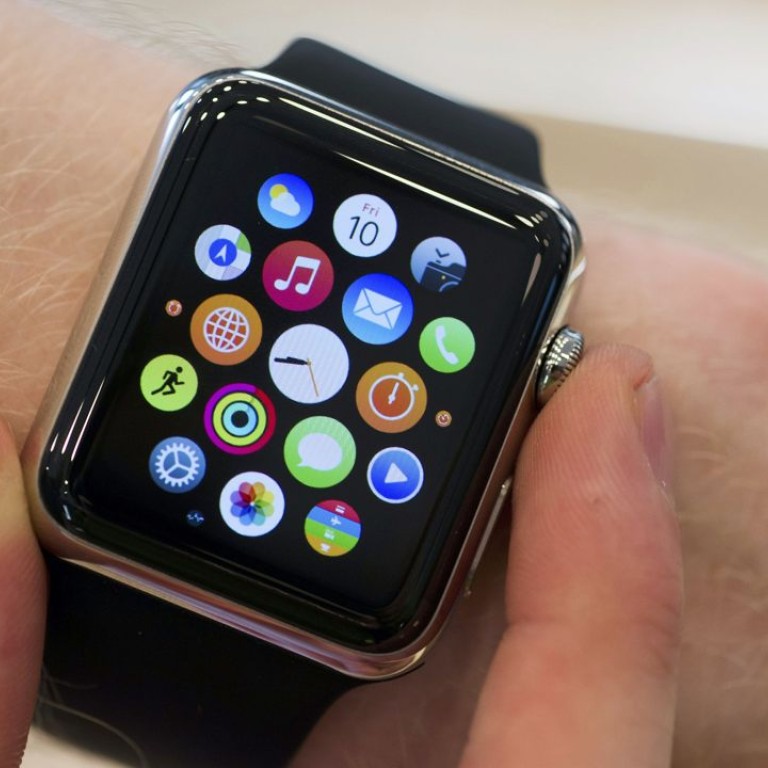
Smartwatch shipments surge to record 6.1 million units in Q3, with China among top markets
Global smartwatch shipments surged more than 500 per cent year-on-year in the third quarter as demand for the Apple Watch continued to grow ahead of the holiday shopping season.
“The United States, [countries in] Western Europe and China are the three big markets driving Apple Watch sales at the moment,” Neil Mawston, the executive director for global wireless practice at technology consultancy Strategy Analytics, told the South China Morning Post.
Strategy Analytics estimated that global smartwatch sales in the three months ended September 30 grew 510 per cent to a record quarterly high of 6.1 million units, up from 1 million in the same period last year.
Apple shipped 4.5 million units for a dominant 74 per cent global market share last quarter.
Samsung Electronics cornered a 10 per cent share with smartwatch shipments of about 600,000 units, while other smartwatch players shipped a combined 1 million units.
Senior analyst Rajeev Nair, of Strategy Analytics, said Apple and Samsung together accounted for eight in 10 of all smartwatches shipped around the world in the three months to September.
Total smartwatch shipments this year are forecast by Strategy Analytics to reach 28 million units, with Apple accounting for 13 million.
Apple, which reported on Tuesday total revenue of US$233.7 billion in fiscal year to September, has declined to provide official sales numbers for the Apple Watch.
The US technology giant’s so-called Greater China operation — comprising the mainland, Hong Kong and Taiwan — saw a 99 per cent year-on-year jump in revenue during the quarter ended September 30 to US$12.5 billion on the back of strong iPhone sales.
“Apple’s brand is popular in China and the Apple Watch is gaining momentum there,” Mawston said. “Apple will need to expand its distribution channels into telecoms operators and other retailers if it wants to make the Apple Watch as big as the iPhone in China.”
The Post reported last month that the number of Apple Watch users in mainland China crossed the one-million mark in August, 17 weeks after the smart wearable device was introduced in the market.
The latest quarterly Apple Watch survey of Shanghai-based research firm RedTech Advisors and the company’s proprietary smart device tracker programme with TalkingData, a so-called big data analytics firm in Beijing, showed that the number of Apple Watch users on the mainland reached 1.07 million as of August 23.
“We track watches that have been activated, not shipped,” RedTech founder and managing director Michael Clendenin told the Post last month.
He added that about 30 per cent of the Apple Watches used on the mainland came from “non-traditional channels”, including the grey market and overseas purchases, since the device was not easily available since it was launched on the mainland, Hong Kong and seven other markets on April 24.
Mawston said the retail presence of the Apple Watch was expanding fast as the device is currently available in more than 30 markets worldwide.
“However, the Apple Watch is still not widely available at most mobile operators, and this is one area of weakness that Apple must improve to maintain its shipment growth in the future,” Mawston said.
He added that if Apple can persuade more Android smartwatch users to make the switch to the iPhone and then adopt the Apple Watch, “more developers could create more Apple Watch apps for its growing ecosystem”.
Apple chief executive Tim Cook on Tuesday announced in the US that there were plenty of smartphone users who have switched to the iPhone from an Android device last quarter, and that there now more than 13,000 apps on the online Watch App Store.
Cook pointed out that “customers who purchased an iPhone last quarter and replaced a smartphone, 30 per cent of those switched from an Android device”.
“That number is the largest that we’ve ever recorded since we began measuring it three or so years ago,” he said.

